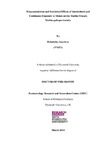Bioaccumulation and sub-lethal effects of intermittent and continuous exposure to metals on the marine mussel, Mytilus galloprovincialis
| dc.contributor.supervisor | Handy, Richard | |
| dc.contributor.author | Amachree, Dokuboba | |
| dc.contributor.other | School of Biological and Marine Sciences | en_US |
| dc.date.accessioned | 2015-01-21T17:07:52Z | |
| dc.date.available | 2015-01-21T17:07:52Z | |
| dc.date.issued | 2014 | |
| dc.date.issued | 2014 | |
| dc.identifier | 375473 | en_US |
| dc.identifier.uri | http://hdl.handle.net/10026.1/3198 | |
| dc.description.abstract |
Aquatic organisms experience intermittent exposure to contaminants. The hazard from such discontinuous exposure may not simply be predicted from existing continuous exposure. Little is known about the bioaccumulation responses of shellfish to metals during intermittent compared to the continuous exposure counterparts. This study was designed to compare the bioaccumulation responses of two metals (Cd and Hg) singly (Chapters 3 and 4) or mixtures (Chapters 5 and 6) during continuous and intermittent exposure. Responses were examined using a multi-assay approach in areas of oxidative stress, osmoregulation, haematology and organ pathology. Tissue metal concentrations were highest in the gill and digestive gland for both metals. The linear or curvilinear pattern of accumulation was observed in the continuous exposure. While an alternating temporal uptake and clearance corresponding with the exposure was observed in the gill (Hg alone) and haemolymph (Cd alone) in intermittent profile. At the end, the study shows that accumulation of Hg or Cd was less in the intermittent compared to the continuous exposure for most tissue. Sub-lethal responses during Hg or Cd alone were similar in both regime apart from the severe pathology in the gill (continuous exposure) and inflammation in the digestive gland (intermittent exposure) observed in the Hg alone treatment (Chapter 4). For Hg plus Cd mixture, the additive effect in accumulation was observed in both exposures. Sub-lethal responses during mixtures were not affected in the intermittent. However, an antagonistic interaction was observed in the TBARS during continuous exposures for all tissues apart from the digestive gland. In terms of risk assessment, regulations for the single metals in continuous exposure will be protective for intermittent events at least for adult M.galloprovincialis. | en_US |
| dc.description.sponsorship | Rivers State Government, Nigeria | en_US |
| dc.language.iso | en | en_US |
| dc.publisher | Plymouth University | en_US |
| dc.subject | Intermittent Exposure | |
| dc.subject | Metal Mixtures | |
| dc.subject | Cadmium | |
| dc.subject | Mercury | |
| dc.subject | Mussel | |
| dc.subject | Bioaccumulation | en_US |
| dc.title | Bioaccumulation and sub-lethal effects of intermittent and continuous exposure to metals on the marine mussel, Mytilus galloprovincialis | en_US |
| dc.type | Thesis | |
| plymouth.version | Full version | en_US |
| dc.identifier.doi | http://dx.doi.org/10.24382/3968 |
Files in this item
This item appears in the following Collection(s)
-
01 Research Theses Main Collection
Research Theses Main


